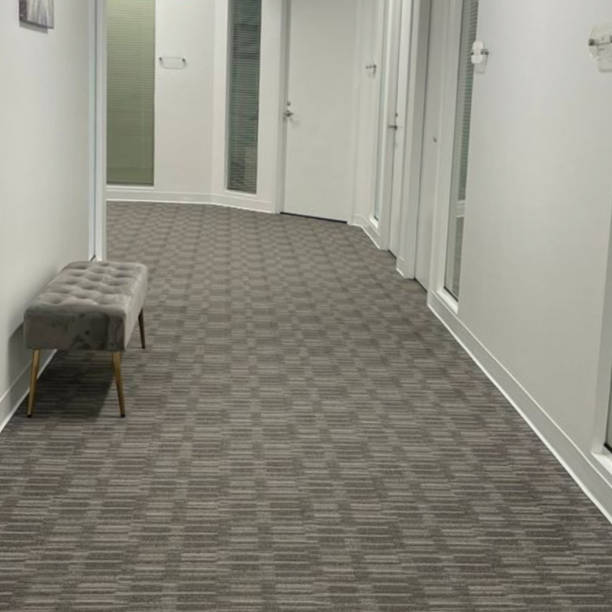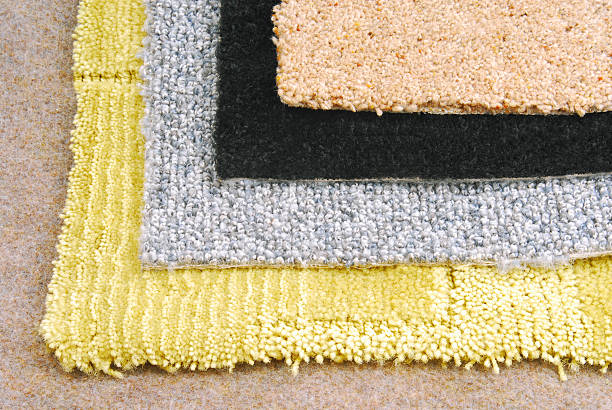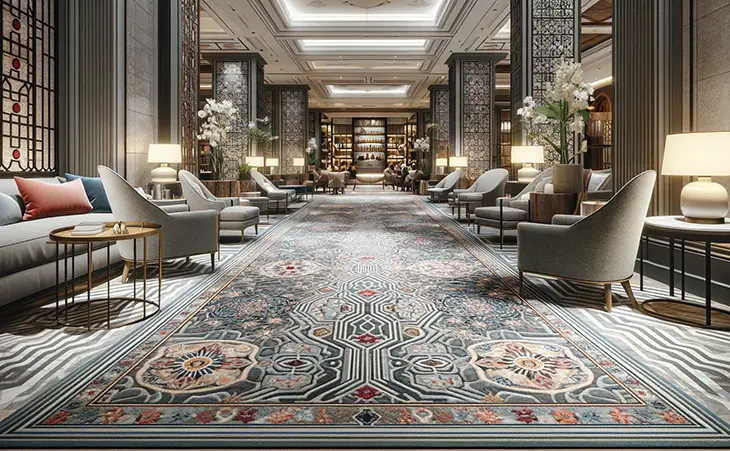Hospitality Carpet Design: Trends, Innovations, and Industry Leaders
When guests step into a hotel lobby, a ballroom, or even a church sanctuary, they often don’t realize that one of the first elements they notice—consciously or subconsciously—is the carpet underfoot. In the world of interior design, particularly when it comes to carpet for the hospitality industry, these floor coverings are far more than just a necessity; they’re a vital design element that sets the tone for the entire space, reflecting the brand’s identity, enhancing the ambiance, and, crucially, enduring the wear and tear of constant foot traffic.
As we look to the future, the world of hospitality carpet design is evolving rapidly. With new patterns, advanced materials, and a keen focus on sustainability, the industry is poised to redefine the spaces we inhabit.
Key Trends in Hospitality Carpet Design

Patterns that Make a Statement
Today’s hospitality carpets are not just about covering floors—they’re about making bold design statements. Geometric patterns, with their clean lines and modern appeal, are a favorite among designers aiming for a contemporary aesthetic. Floral and abstract designs, on the other hand, bring a touch of nature and artistry indoors, creating a sense of elegance and creativity.
Large-scale designs are also gaining traction, particularly in expansive spaces like ballrooms and lobbies, where the carpet needs to command attention. These patterns, often custom-made, are carefully crafted to harmonize with the architecture and overall design theme of the space.
A Palette of Possibilities
Color plays a pivotal role in the emotional impact of a space. The current trend leans toward a sophisticated palette of grey tones and modern neutrals, which provide a versatile foundation for various interior styles. However, bolder hues like rich reds and deep blues are also making a comeback, particularly in spaces where the carpet is meant to be the star of the show.
Design Themes: From Luxury to Oriental Influences
Whether it’s the understated luxury of a modern hotel or the ornate beauty of an oriental-inspired ballroom, the thematic design of hospitality carpets is diverse. Luxury influences are seen in the use of plush textures and intricate patterns, while oriental inspirations bring a sense of history and cultural richness to the space. Contemporary styles, with their sleek and minimalistic approach, continue to dominate urban hotels and trendy venues.
Carpet Types and Applications

Broadloom Carpets: A Staple of Large-Scale Design
Broadloom carpets, woven on a wide loom, remain the go-to choice for large, uninterrupted expanses of flooring. Their seamless appearance is particularly valued in high-profile areas like ballrooms and lobbies, where they contribute to a unified, elegant look. Designers often choose broadloom for its ability to create custom patterns that flow smoothly across the floor, adding a layer of sophistication to any space.
Carpet Tiles: Flexibility Meets Functionality
In contrast to broadloom, commercial carpet tiles offer unparalleled flexibility. Their modular nature allows for easy installation and replacement, making them ideal for high-traffic areas like corridors. With the ability to mix and match, carpet tiles also offer endless design possibilities, enabling designers to play with color and pattern in innovative ways.
Printed Carpets: Precision in Design
Advances in printing technology have brought printed carpets to the forefront of hospitality design. These carpets are favored for their ability to replicate complex patterns with precision, making them perfect for custom designs. Printed carpets are particularly popular in themed spaces, where every detail matters in creating an immersive experience.
Axminster Weave: The Epitome of Luxury
For those seeking the pinnacle of luxury, Axminster weave carpets offer a blend of tradition and innovation. Known for their durability and intricate designs, Axminster carpets have a rich history dating back to the 18th century. Today, they are a top choice for luxury settings, from grand hotel lobbies to bespoke guest rooms, where they offer both aesthetic appeal and long-lasting performance.
Rugs and Border Designs: Defining Spaces
Rugs and border designs play a crucial role in hospitality settings, particularly in defining areas within a larger space. Whether it’s a plush rug in a lobby or an ornate border in a ballroom, these elements add layers of texture and detail that enhance the overall design. Rugs are often used to create a sense of intimacy in otherwise expansive spaces, offering both comfort and style.
Design Considerations for Specific Spaces
Hotels: Where Comfort Meets Luxury
In hotel design, carpets must balance comfort with luxury. Guest rooms often feature plush, soft carpets that invite guests to relax, while public areas like lobbies and corridors require durable materials that can withstand heavy use without compromising on aesthetics. Custom designs are frequently employed to reflect the hotel’s brand identity, creating a cohesive experience from the moment guests step through the door.
Ballrooms and Event Spaces: Making a Grand Impression
Ballrooms are where large-scale designs truly shine. The carpet in these spaces is often the centerpiece, with bold patterns and colors that enhance the grandeur of the setting. Durability is key, as these areas host events ranging from weddings to corporate functions, requiring carpets that can endure while still looking impeccable.
Corridors and Lobbies: The Intersection of Style and Durability
Corridors and lobbies see some of the highest foot traffic in any hospitality setting. Here, the challenge is to find carpets that are not only stylish but also resilient. Carpet tiles are a popular choice, offering both functionality and design versatility. In lobbies, where first impressions are made, the carpet often sets the tone, requiring careful consideration of both pattern and color.
Churches: A Balance of Tradition and Modernity
In churches, carpet design must balance reverence with functionality. Traditional patterns often blend with modern materials to create spaces that are both sacred and inviting. Durability is essential, as these carpets must accommodate large congregations and frequent use while maintaining a sense of spiritual calm and beauty.
The Future of Hospitality Carpet
As we look ahead, the future of carpet for the hospitality industry is bright with innovation. Sustainability is becoming a central concern, with manufacturers developing eco-friendly materials and processes that reduce environmental impact without sacrificing quality. Patterns and designs are also evolving, with a growing emphasis on personalization and customization, allowing spaces to reflect the unique identities of the brands they represent.
In conclusion, carpets in the hospitality industry are more than just functional floor coverings—they are integral to the design narrative of each space. As trends evolve and new technologies emerge, the role of carpet design in enhancing the guest experience will only continue to grow, solidifying its place as a key element in hospitality interiors.




